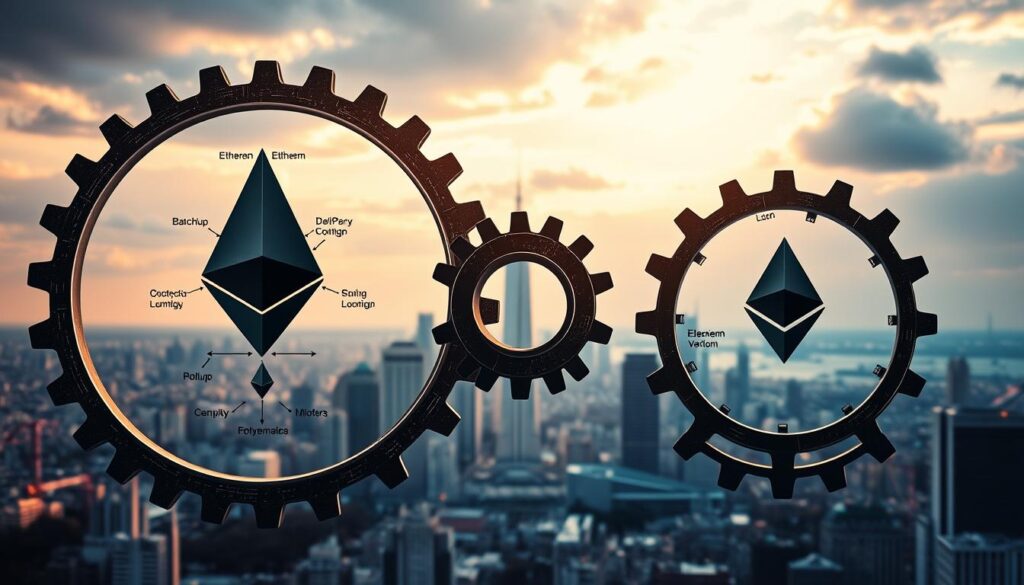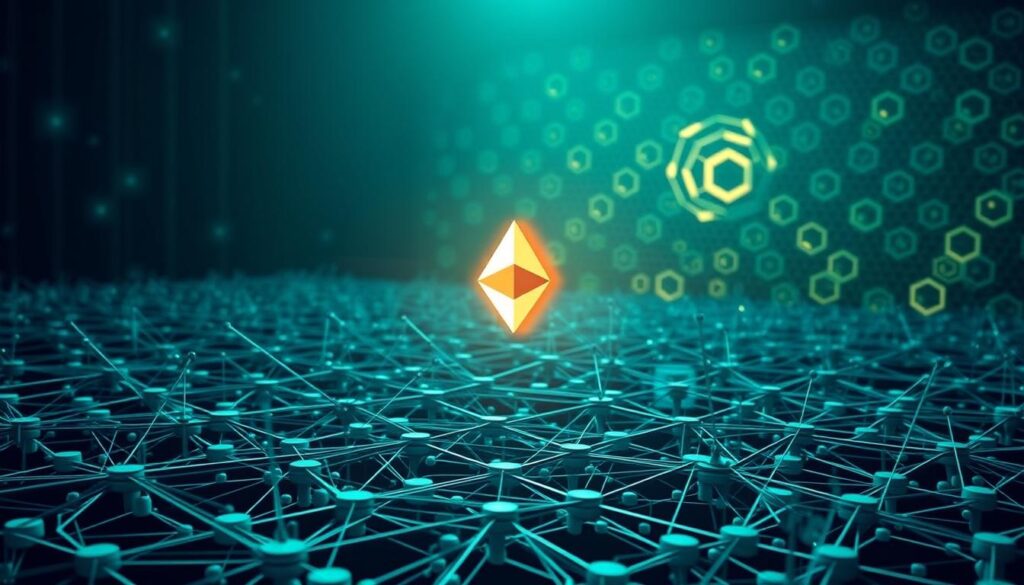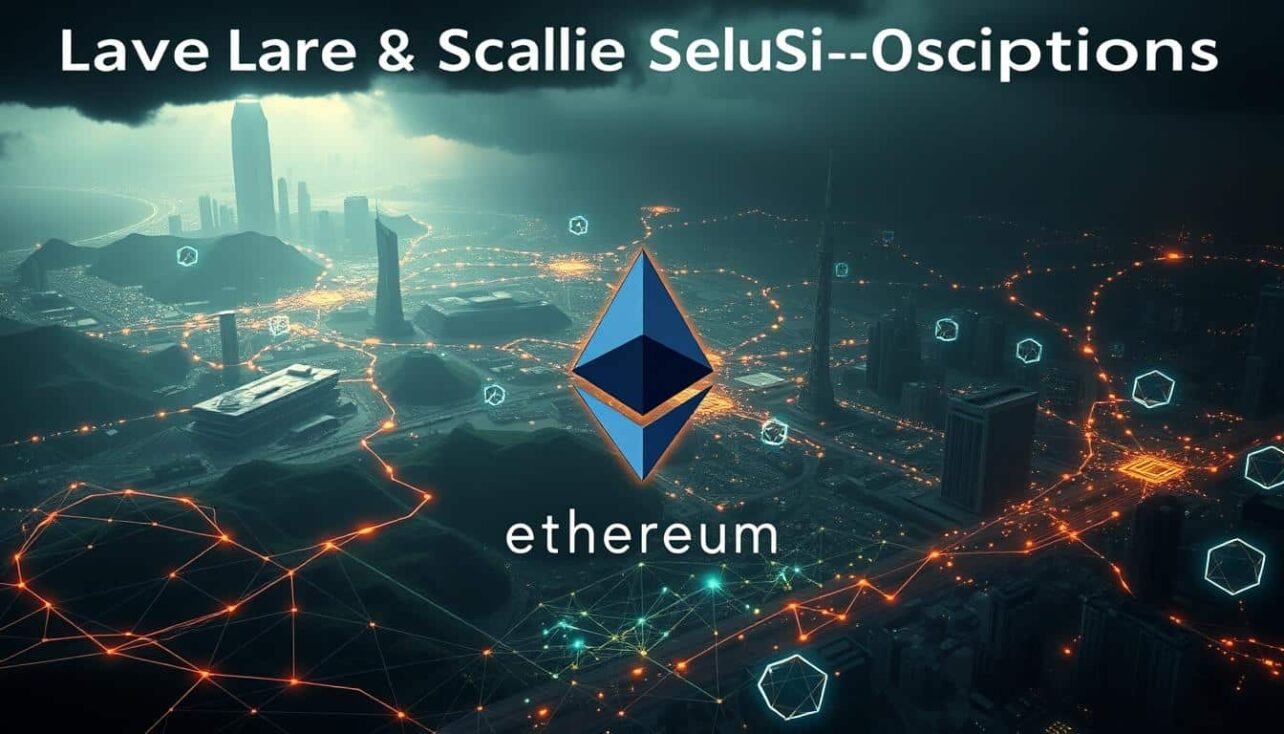Digital networks powering decentralized apps and financial tools face a major challenge: handling millions of users without slowing down. In January 2024, one leading platform hit 2 million daily transactions, driven by surging demand for financial services, digital collectibles, and interactive gaming. This explosive growth revealed bottlenecks in traditional systems, where limited capacity leads to delays and costly fees.
New technologies now address these limitations by moving activity off the main network. These innovations process transactions 11 times faster while slashing costs by over 90%, according to recent data. By maintaining core security standards, they enable seamless experiences for developers and everyday users alike.
This guide breaks down how these advancements work and why they matter. You’ll learn how modern networks balance speed with decentralization, support next-gen applications, and pave the way for mainstream adoption. Let’s explore the tools reshaping how digital ecosystems evolve.
Key Takeaways
- Leading decentralized networks now handle millions of daily transactions, creating urgent demand for efficiency upgrades
- Advanced protocols process over 10x more activity than traditional systems while reducing costs dramatically
- Next-generation architectures solve congestion issues without compromising security or user control
- These improvements directly support emerging sectors like decentralized finance and immersive web3 experiences
- Scalability breakthroughs are critical for enabling global adoption of decentralized technologies
Understanding Ethereum’s Scalability Challenges
As decentralized apps attract millions of users, a critical problem emerges: how to manage growth without sacrificing performance. Platforms handling financial trades, digital art sales, and virtual worlds need instant, affordable operations – but face inherent limitations in their foundational architecture.
Network Congestion and High Gas Fees
When too many users interact simultaneously, systems slow down. This isn’t unique to digital networks – imagine 50 cars trying to merge into a single highway lane. On Ethereum, this bottleneck causes gas fees to spike, sometimes exceeding the transaction’s actual value. During an NFT minting frenzy in 2023, average costs briefly hit $200 per action.
Traditional payment processors like Visa handle 1,700 transactions per second. Ethereum manages 15-30. This disparity creates queues during peak times, forcing users to bid higher fees for priority processing. It’s like paying extra at a toll booth to skip traffic.
Transaction Speed and Throughput Limitations
Finalizing payments takes about 15 minutes – impractical for buying coffee or playing real-time games. This delay stems from Ethereum’s security-first design, which requires multiple network confirmations. While safe, it’s far slower than credit card systems that approve purchases in 2-3 seconds.
The blockchain trilemma explains why these trade-offs exist. Developers prioritize security and decentralization, leaving scalability as the challenge to solve. New approaches now address this gap, creating faster alternatives without compromising core principles.
The Role of Layer 2 Scaling Solutions in Blockchain
Modern distributed systems achieve unprecedented efficiency by shifting workloads from congested core networks to specialized environments. These complementary frameworks process transactions through parallel channels while anchoring trust in the original chain’s infrastructure.

Offchain Transaction Processing Explained
Secondary networks operate like express checkout lanes at busy stores. They handle thousands of actions privately before submitting batched summaries to the main system. This approach cuts processing costs by 90% compared to traditional methods, according to 2024 blockchain analytics.
Validators ensure accuracy through cryptographic proofs before finalizing results on the primary ledger. Users interact with dApps as usual but experience faster confirmations and lower fees. It’s how next-gen platforms support instant micropayments and complex smart contracts simultaneously.
Enhancing Decentralization and Security
These protocols strengthen network resilience by distributing computational tasks across independent nodes. Unlike centralized alternatives, they require multiple participants to verify offchain activity before mainnet settlement. This design prevents single points of failure while maintaining censorship resistance.
Security mechanisms inherit the base chain’s battle-tested protections. Every offchain bundle includes fraud-proof capabilities, letting anyone challenge invalid transactions. By balancing innovation with proven safeguards, these systems expand possibilities without sacrificing user control.
How layer 2 scaling solutions for ethereum blockchain Transform User Experience
Everyday blockchain interactions are undergoing a radical shift. Offchain protocols now enable seamless experiences that feel more like using a credit card than experimental technology. This evolution removes economic and technical friction that once limited mainstream adoption.
Democratizing Access Through Affordable Actions
Gone are the days of $200 network fees. Today’s advanced systems process micropayments for less than a penny – 99% cheaper than traditional mainnet costs. A DeFi swap that once cost $15 now averages $0.03, while NFT trades settle for fractions of a cent.
This pricing revolution unlocks new possibilities:
- Game developers integrate blockchain features without pricing out players
- Artists monetize digital creations through tiny royalty percentages
- Unbanked populations access financial tools through $0.10 transactions
Instant Confirmations Reshape Expectations
Waiting 15 minutes for payment confirmation feels archaic compared to modern standards. Next-gen networks achieve sub-second finality, letting users:
- Trade assets as fast as stock market orders
- Interact with dApps in real-time
- Stream payments per second for services
These speed improvements make blockchain applications competitive with Web2 platforms. A decentralized exchange now matches Coinbase’s execution times, while play-to-earn games support split-second item trades.
State Channels, Rollups, and Sidechains: Comparing the Options
Three primary approaches dominate efforts to boost transaction capacity while preserving security. Each method employs distinct mechanisms for balancing speed, cost, and decentralization – critical factors shaping real-world adoption.

Optimistic Rollups vs. Validity Rollups
Optimistic rollups operate on trust-first principles. They batch transactions offchain and assume validity unless challenged. Platforms like Arbitrum use a 7-day dispute window where anyone can submit fraud proofs. This design minimizes computational overhead but delays fund withdrawals.
Validity rollups (ZK-rollups) take the opposite approach. Starknet and zkSync generate cryptographic proofs for every transaction bundle. These mathematical guarantees enable instant settlements but require specialized hardware. While more complex to implement, they eliminate trust assumptions entirely.
Pros and Cons of Using Sidechains
Sidechains like Polygon operate as independent networks with custom consensus rules. Their two-way bridges let users move assets between chains freely. This architecture supports high throughput – Polygon processes 7,000 transactions per second – but introduces new security considerations.
Key trade-offs include:
- Faster transactions vs. reliance on separate validator sets
- Lower fees at the potential cost of decentralization
- Custom features requiring developer adaptation
State channels offer another path, enabling instant micropayments between predefined participants. These sealed payment corridors work best for recurring transactions between trusted parties, like streaming services or gaming leaderboards.
Technical Breakdown: How Layer 2 Solutions Process Transactions
Modern protocols handle high volumes by rethinking how operations are structured and verified. By moving computation away from crowded networks, these systems achieve speed without sacrificing reliability.

Bundling Transactions Offchain
Offchain networks act like digital assembly lines. They collect hundreds of actions – swaps, trades, or game moves – into single packages. This batching cuts storage needs by 80% compared to individual processing.
Validators check these bundles using predefined rules. Only approved batches proceed to final verification. This approach lets users enjoy instant confirmations while keeping costs below $0.01 per action.
Onchain Settlement and Cryptographic Proofs
Approved batches return to the main network as compressed data packets. Zero-knowledge proofs verify accuracy without revealing details. One cryptographic seal can represent 10,000 validated actions.
Two main methods dominate this space:
- ZK-proof systems provide mathematical certainty in seconds
- Optimistic models allow challenge periods for dispute resolution
Both approaches reduce mainnet workload by 95% while maintaining security through decentralized consensus. Developers choose based on their app’s speed needs versus finality requirements.
Security Considerations and the Blockchain Trilemma
Building secure networks requires navigating complex trade-offs between three critical factors. The blockchain trilemma forces architects to prioritize either security, decentralization, or scalability – but never all three equally. Modern protocols tackle this challenge by anchoring trust in existing systems while innovating through secondary frameworks.

Balancing Security, Decentralization, and Scalability
Every efficiency improvement carries potential risks. Protocols maintain security through cryptographic links to their parent chain while enhancing transaction capacity. Validators play crucial roles in this balance – some networks use permissionless participation, others rely on certified operators.
Optimistic systems assume transactions are valid unless challenged. This approach preserves decentralization but requires seven-day waiting periods for full confirmation. Alternative methods use mathematical proofs to instantly verify actions, prioritizing speed over flexible participation.
Addressing Potential Vulnerabilities with Fraud Proofs
Dispute resolution mechanisms form the backbone of trust in optimistic systems. Anyone can submit fraud proofs during challenge windows to flag invalid transactions. These safeguards prevent malicious activity but introduce delays in fund availability.
Zero-knowledge alternatives eliminate trust assumptions through complex computations. Their validity proofs provide ironclad verification in seconds, though requiring specialized hardware. This method trades higher initial setup costs for stronger security guarantees.
| Security Feature | Optimistic Approach | Validity Approach |
|---|---|---|
| Trust Model | Assume honesty | Cryptographic proof |
| Finality Time | 7 days | Instant |
| Energy Use | Low | High |
| Validator Requirements | Open participation | Specialized nodes |
Consensus mechanisms vary widely across implementations. Some maintain full decentralization through tokenized voting, while others optimize for speed with selected validator groups. Users must weigh these differences when choosing platforms for specific needs.
Real-World Applications and Benefits of Layer 2
From coffee loyalty cards to million-dollar gaming economies, secondary networks are reshaping how industries interact with decentralized technology. These frameworks unlock practical use cases that merge blockchain’s potential with real-world usability.
Enhanced Efficiency for DeFi and DApps
Decentralized exchanges now process trades at 0.1% of original costs using ZK-rollups. Lending protocols handle thousands of micro-loans daily through batched transactions. This efficiency revolution enables:
- Instant collateral swaps between assets
- Sub-dollar yield farming strategies
- Cross-platform borrowing without fee barriers
Major platforms report 300% user growth after migrating to optimized networks. Developers launch feature-rich dApps previously hindered by mainnet constraints.
Impact on NFT Marketplaces and Blockchain Gaming
Digital collectibles marketplaces eliminated minting fees through specialized chains. Popular games process 50,000+ hourly item trades without congestion. Key breakthroughs include:
- Gas-free secondary sales on ImmutableX
- Instant weapon upgrades in Axie Infinity’s Ronin ecosystem
- Dynamic royalty splits for collaborative art projects
Starbucks’ Odyssey loyalty program demonstrates mainstream adoption, using Polygon for 2 million+ NFT-based rewards. Players earn real income through seamless in-game economies once limited by slow confirmations.
Challenges Facing Layer 2 Technology and Their Solutions
Innovative protocols encounter unexpected hurdles when expanding network capabilities. While secondary systems boost speed and affordability, they introduce technical obstacles requiring creative fixes. Developers and users alike face fresh complexities in this evolving landscape.
Complexity in Implementation and Integration
Building on optimized networks demands new technical skills. Many frameworks use unfamiliar programming languages or unique security models. This creates steep learning curves – a recent survey showed 68% of developers need 3+ months to master these environments.
Solutions like streamlined development platforms simplify the process. Validity proofs automate security checks, while modular toolkits handle chain interactions behind the scenes. These advances let teams focus on core features rather than infrastructure.
Ensuring Liquidity and Cross-Chain Interoperability
Fragmented assets across multiple chains create friction. A DeFi protocol might hold reserves on three different networks, complicating swaps. Cross-chain bridges solve this by enabling instant transfers – Polygon’s solution moves $50M daily between ecosystems.
Emerging standards unify communication protocols. Systems like IBC (Inter-Blockchain Communication) allow seamless asset movement while maintaining audit trails. Combined with liquidity pools, these tools prevent market isolation and keep transactions flowing smoothly.
Future Trends and Innovations in Layer 2 Scaling
Innovation continues to reshape how decentralized systems manage growth and performance. Hybrid approaches now merge multiple technologies to address specific needs while maintaining core principles. Developers combine speed-focused architectures with security-first designs, creating tailored solutions for evolving markets.
Emerging Hybrid Solutions and Specialized Networks
Next-gen frameworks blend rollup efficiency with sidechain flexibility. These models allow chains to handle gaming microtransactions at scale while supporting enterprise-grade DeFi operations. Custom networks now process insurance claims and supply chain data through purpose-built environments.
Adoption Trends Among Major Blockchain Projects
Leading platforms like Polygon and Arbitrum report 400% growth in developer activity since 2023. Financial institutions now test private scalability tools for cross-border settlements. This surge reflects broader adoption patterns, with 78% of new dApps choosing optimized networks over traditional infrastructure.
As technology matures, expect tighter integration between specialized systems and legacy platforms. These advancements will drive global accessibility while preserving the decentralized ethos that powers modern digital ecosystems.


No comments yet